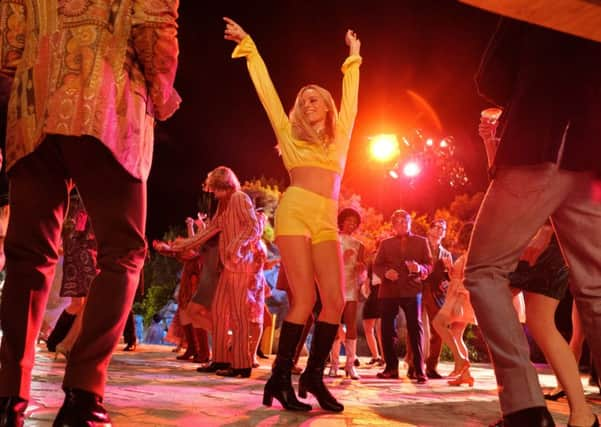Film review: Once Upon A Time... in Hollywood (18)


Once Upon A Time... in Hollywood (18) *****
Set in Los Angeles over a few days in 1969, Quentin Tarantino’s Once Upon a Time... in Hollywood is a wild cinematic excoriation of a moment in pop culture history when everything changed and nothing changed. Like his demented Second World War film Inglourious Basterds, it deploys a twisted fairytale structure to serve up a mythical vision of the entertainment industry as it collides with real world events. The result is both a gorgeous celebration of everything that’s magical about the movies and a savage exposé of everything disturbing lurking just beneath the surface of the industry and on its fringes.
Those real world events are, of course, the Manson murders and while Tarantino uses them – or more specifically our knowledge of them – to ratchet up a palpable sense of dread, they’re not here to function as yet another cliché-ridden, Joan Didion-influenced signifier of the end of the Sixties. If anything, his decision to make murdered actress Sharon Tate (played by Margot Robbie) one of his main characters goes some way to rescuing her legacy from the true crime narratives that have used her status as the beautiful and pregnant wife of Roman Polanski to reductively immortalise her as the ultimate tragic victim.
Advertisement
Hide AdIn Once Upon a Time… in Hollywood, the wilfully languid pacing that’s become one Tarantino’s less celebrated directorial signatures is deployed to let us hang out with Robbie’s Tate as she wanders LA by herself, taking in a public screening of her new movie – the Dean Martin-starring James Bond spoof The Wrecking Crew – and delighting not just in seeing her own performance up on screen, but in hearing the audience’s appreciation of her comic gifts. Though Tarantino has, inevitably, been criticised for not giving Robbie much dialogue, this scene makes it clear that he doesn’t need to; Robbie’s face conveys Tate’s interior life as a star-in-the-making so brilliantly that the constant jabbering for which Tarantino’s scripts have become famous isn’t just unnecessary for this character, its absence – like the absence of any significant characters of colour in the movie (another rarity for Tarantino) – functions as its own subtle critique of the parameters of the dying studio system at this point in time.
Before Tarantino gets to Tate or the Manson family, though, he introduces us to his other two main characters, both stalwarts of that dying system. The first is Leonardo DiCaprio’s Rick Dalton, a moderately successful actor too blinded by the old way of doing things to see that his career may not be on the permanent downward spiral he fears it is. The second is Rick’s stunt double and driver Cliff Booth (Brad Pitt), who seems to have made peace with being Rick’s professional gopher. It’s through the prism of Rick and Cliff that we see the events of 1969 play out and Tarantino packs so much into their relationship and into the way he shoots them, the film operates both as a great buddy movie and an extraordinarily layered dramatisation of a transitional moment when the studio system with all its certainties gave way to the brief period of radicalisation that became known as New Hollywood.
Rick and Cliff are caught in that switch. Early on, Rick, a peer of Steve McQueen who hasn’t managed to make the transition from starring on a successful TV Western to starring in movies, has his eyes opened to his impending obsolescence by a producer (played Al Pacino) who wants him to go to Italy to star in Spaghetti Westerns. Although he owns a nice house in the Hollywood Hills (one that Tarantino ominously places next door to Tate’s and Polanski’s) and has regular employment on serial TV, this realisation terrifies him and DiCaprio is brilliant at capturing that insecurity. He gets the way it infects Rick and colours his view of the industry and of the counterculture threatening his livelihood, but also how it inspires Rick to both up his game and beat himself up whenever he lets his drinking get in the way of his abilities.
As you’d expect, Tarantino takes great delight in giving us a potted history of Rick’s career by creating movies and TV shows for him to star in. Running the gamut from a wonderfully rendered old school war epic called 14 Fists of McClusky to the fake Sergio Corbucci and Fernando Di Leo-style genre films he goes off to make in Europe, these aren’t just ways for Tarantino to indulge his love of genre trash; they’re a way of offering a fuller picture of machinations of the movie business during this period than tends to be found in all the accounts desperate to mythologise New Hollywood’s subsequent dominance in the 1970s (a decade in which Clint Eastwood and Burt Reynolds emerged as its biggest stars).
Pitt is also the best he’s ever been. He plays Cliff as a likeable underdog whose character’s heroic status is complicated by an ambiguous revelation about his past that forces us to reckon with the way Hollywood works, especially the degree to which scandal seems to be tolerated on a sliding scale of success. It’s Cliff who has the first encounter with the Manson family and though it would be remiss to go into too much detail about the ways these two worlds start colliding, the way Tarantino films the Manson girls scavenging around LA for food like something out of a dreamy daylight-set horror film works as brilliant flip-side to the romanticised Hollywood of Rick, Cliff and Tate. Both worlds are built on illusions and when they eventually clash in the bloody finale what’s left, ultimately, is an audacious celebration of the power of movies to reshape our lives. It’s the film Tarantino says he feels like he’s been working towards his whole career. It’s also the best thing he’s done.